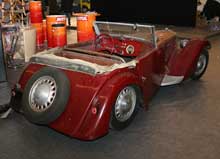Let Georges Do It
At first glance you might think this is a Morgan Plus Four. The resemblance is such that you may be forgiven for doing so, but this is about as unMorgan a car as you could imagine. A look at the front reveals no familiar cowled radiator grille. A closer look reveals a differential lurking behind the grille, for this is a front-wheel drive car. The badge tells the story: Georges Irat.
Born in Arcachon, France, in 1892, Georges Irat went to Paris at age 20 to enter the motor trade. By the time World War I ended he was in charge of the Majola factory, which made a range of light touring cars. Irat began the production of his own car, bearing his name, in 1921. Its ohv four-cylinder engine was designed by Maurice Gaultier, formerly of Delage, and the car had servo-assisted brakes on all four wheels. Production ranged from 100 to 200 cars a year. Bodies came from outsource carrosseries, like this attractive cabriolet by Portout, who would later body the Peugeot Eclipse. This car is a 1927 Model A. A six-cylinder car was added to the range that year also.
In the early thirties, Georges Irat offered some series of cars with American engines, but these were not successful. With backing from Godefroy et Levecque, makers of Ruby engines, he began building the sporting car seen above. Called the 6CV from its French horsepower rating, it used an 1,100 cc Ruby engine driving the front wheels. About 1,500 were built from 1935 to 1939, the most successful Georges Irat then or now.
In 1938, he introduced a new front-drive sporting car, which used an 11CV engine from the Traction Avant Citroen. Only about 200 were built by the time World War II halted production. After the war, a radical new car was shown at the Paris Salon. Powered by an 1,100 cc flat four, it had a magnesium chassis and body. Also front-wheel drive, it had the engine located above the transmission. This three-headlamp version appeared at the '49 show, but nothing came of it. After a brief attempt to build Jeep-like vehicles with Dyna Panhard engines, Georges Irat exited the automobile business entirely in 1953. He retired to his home town, where he died in 1971.

